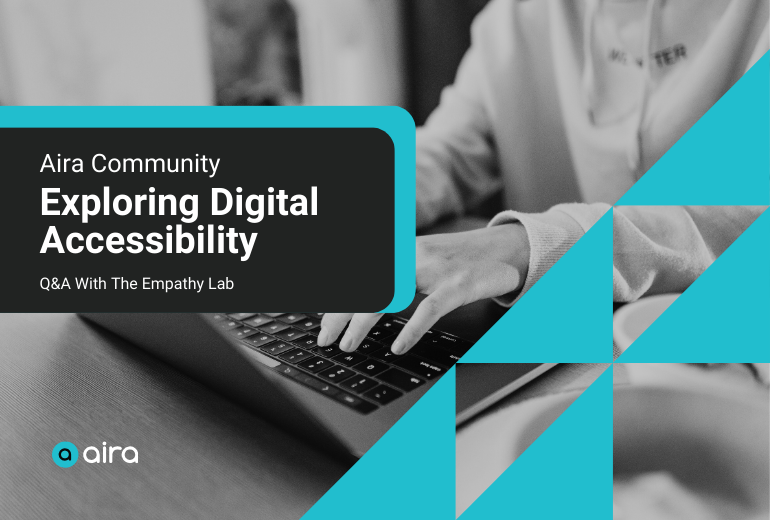The State of Colorado leads by example when it comes to providing equal access to state services. In 2023, the State of Colorado became an Aira Access Partner, meaning that any Coloradan could connect with a Visual Interpreter for free when using services, either online or in person, or navigating state locations. This past summer, the program was expanded to include the availability of Aira at all 42 Colorado State Parks, enhancing the ways blind and low-vision residents can interact with the natural world. This is part of the state’s mission to create a Colorado for All, and offer tools to support inclusivity and accessibility.
We wanted to learn more about The Empathy Lab, an initiative from the Colorado Governor’s Office of Information Technology. Check out our Q&A below with them below, and learn about the mission of this exciting project.
Can you share how the Empathy Lab Project came to be?
The Empathy Lab is a special project funded via grants awarded through SIPA’s Innovation Fund. The lab is currently focused on three key initiatives: The Community
Steering Committee, the Digital Accessibility Workshop, and the Lived Experiences Library. You can learn more by visiting the Empathy Lab site.
What are the goals of the Empathy Lab Project?
- Utilize the CSC to provide a direct feedback loop with Coloradans experiencing barriers to technology, including but not limited to living with a disability, identifying as low income, being a person of color, living in a rural area, etc.
- Provide demonstrations utilizing assistive technology to grow awareness and understanding about the importance of accessibility and equitable access.
- Provide a public workshop site to allow interested parties to interact with inaccessible and accessible digital products, as a way of expanding their awareness around accessible design.
- Develop and implement a Lived Experiences Library, which will provide one-on-one, group, and panel discussions aimed at bettering our understanding of accessibility, equity, and diversity in order to help create more inclusive and innovative digital products. These discussions include: storytelling, user experience feedback and user demonstrations.
Can you share why empathy and understanding other peoples’ lived experiences is such an important element of expanding digital accessibility?
By creating a partnership among OIT, TAP and representatives from historically marginalized communities that have experienced barriers to digital technology and products (e.g., racial and ethnic populations, people with disabilities, rural community populations, people over the age of 65, LGBTQIA+ communities, people who speak English as a second language, people experiencing homelessness, gender identity) we can further the common goal of developing inclusive, accessible technology.
Storytelling is a powerful and effective tool. The CSC has so much to offer and share to help inform the accessible and equitable design of digital products and services. When centering the human experience in the design process, one can learn about how real people interact with the digital world, thus, creating a more accessible and equitable experience.
What do you think people who do not have much prior knowledge about web accessibility will get out of going through the Digital Accessibility Workshop?
The workshop is a virtual inclusion and awareness site with elements that have been informed by a 10-member Community Steering Committee. It is designed to build awareness, empathy and desire to create accessible and equitable digital products. The site includes interactive exercises across eight (8) different topics that show how people with disabilities experience web pages, forms, colors, and more. Some of the exercises are intentionally inaccessible in order to help learners gain a deeper understanding of how users experience technology in different ways.
What was the process of designing the workshop like, and how were the exercises chosen?
The TAP Team factored in experiences with users across more than 15 departments and utilized user experience (UX) and User Interface (UI) principles and best practices.
How do you see improved digital accessibility affecting quality of life for Colorado residents?
We are still working on a process to measure our success, so we can answer this more effectively in the future. For now, a simple message that accessibility truly benefits everyone!
What kind of feedback have you heard from Colorado residents on the Empathy Lab Project and the Digital Accessibility Workshop so far?
From our users:
“This was an excellent training! Thank you for developing this tool to help teach us to create accessible tools and content. It helped me identify things that I have used in the past that weren’t accessible so that I have a place to start in changing my digital communication habits.”
“This was a wonderful journey and insight into the lives of differently abled persons and will help me understand the road blocks they may encounter if purposeful design and accessibility mindset isn’t kept at the forefront.”
“Great training with great examples! I definitely have a better understanding of the struggles people can have trying to navigate and use forms, the internet, etc. I am definitely going to be more mindful moving forward and sharing ideas with my team.”
What are some of the key takeaways you would hope people who create and oversee digital spaces take from this project?
- It is important to center the human experiences
- Make the space to include all voices at the design table, so you are not inadvertently leaving groups of people out
- Little strides go along way – there is nothing wrong with starting small and chipping away at digital equities…accessibility is a marathon, not a sprint
- Stop and listen to those around – use stories and experiences to design even better, more inclusive and equitable digital products
